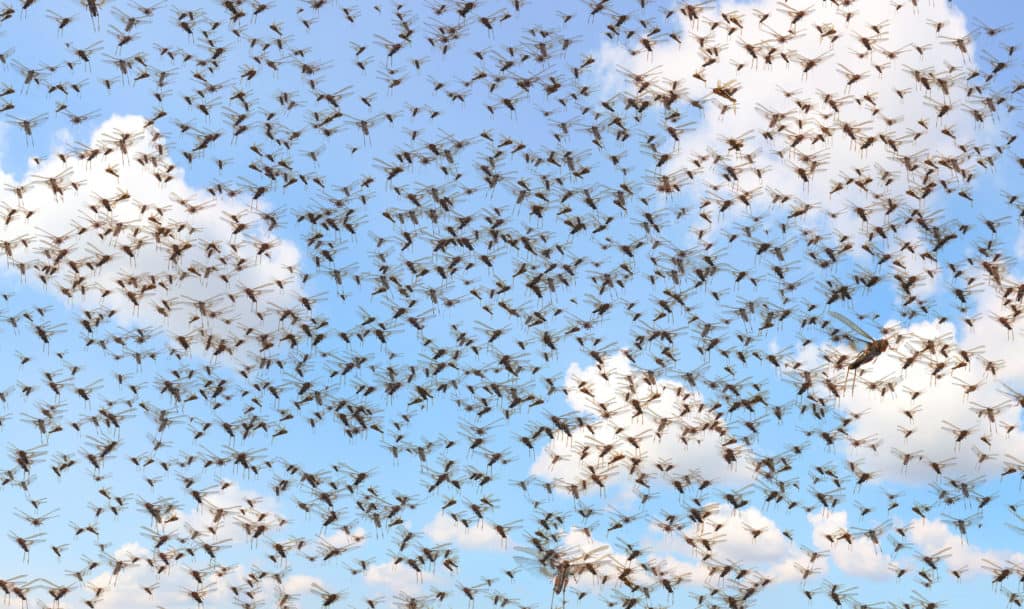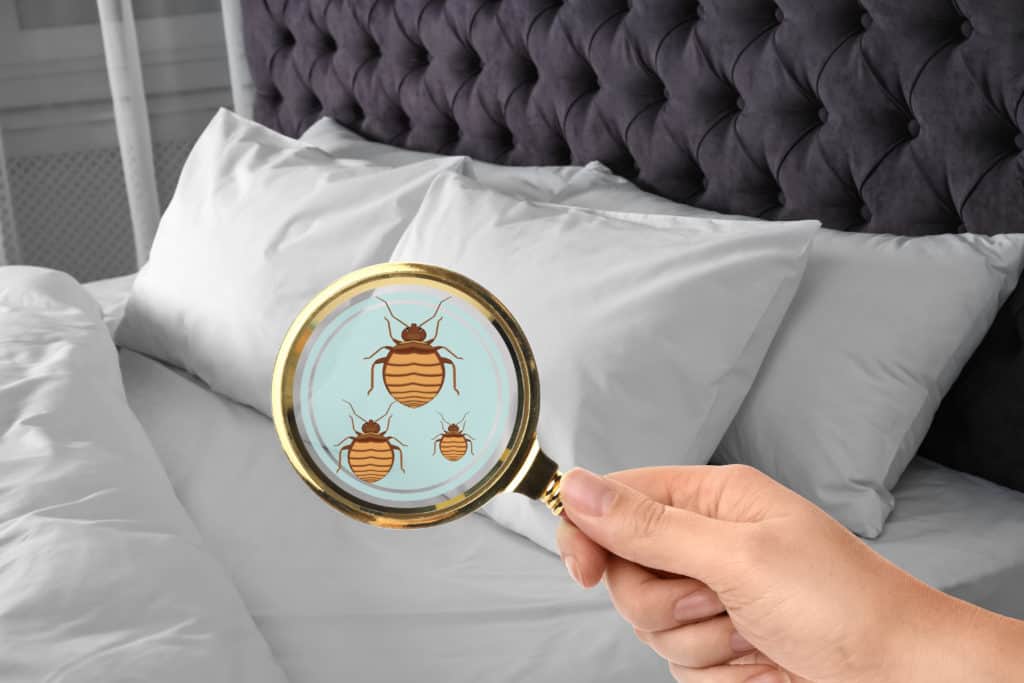A History of Destructive Pests – Part 2
A History of Destructive Pests – Part 2
A Constant Earthly Annoyance
Pests have been pestering since… well, the beginning of time on Earth. There is plenty of data throughout history cataloging the problems pests caused and the massive innovations we have taken to avoid them, as well as significant evidence that pests bugged humans and non-humans alike in prehistoric times as well.
This Blog Series covers these historical effects of pests. In this entry, we cover: the Year of the Locust, as well as Bed Bugs & Bat Bugs.
The Year of the Locust
Locusts are Orthoptera within the Acridoidea family. While they are technically a type of grasshopper, they diverge from other grasshoppers due to their ability to migrate and form large swarms. These herbivores are notorious for seriously damaging crops and swarming in frenzied masses.
One such mass swept across the United States in 1875 with record-breaking size. Measuring 1,800 miles long and 110 miles wide, the swarm was described as “a moving, struggling gray-green screen between the sun and Earth.” A settler in Kansas at the time commented that he “never saw such a sight before… we could see millions in the air. They looked like snowflakes.” Supposedly, the sky was blotted out for nearly five days as the swam traveled across the Great Plains. The carnage that ensued led to the destruction of over $200 million worth of crops, mutilated local forests, and even demolished wooden fences.
The swarm was eventually called “Albert’s Swarm,” so named for the physician, county judge, and amateur meteorologist Albert Child who documented the swarm in depth. In his documentations, Child managed to calculate its total size to be a jaw-dropping 198,000 square miles.
Surprisingly, as rapidly as these pests came, they also quickly disappeared. There are a variety of theories regarding what happened to the massive population of insects… but some people suggest that the insects may be in a form of diapause (insect hibernation) with a long brood cycle (a designated period of time that a new generation of the insect emerges from diapause) meaning that this massive hoard may eventually return.

Bed Bugs and Bat Bugs
Both bed bugs and bat bugs are members of the Cimicidae family and feast on the blood of mammals. The primary difference between these two bloodsucking bugs is actually the mammals that they feed on. Bat bugs, true to their names, primarily feed on bats, while bed bugs primarily feast on us.
Initially, it was believed that the specific genus of bed bugs that feed on humans evolved several million years ago from bat bugs. As early humans shared the caves with these bats, it was assumed that the bugs adapted to also feeding off humans as a secondary source of blood. However, after 15 years of analyzing the DNA of 34 bed bug species collected from 62 different locations, a team of researchers managed to corroborate a 2008 finding by Dr. Michel Engel, an Entomologist at University of Kansas, in which an early ancestor of the modern bed bug was found encased in a prehistoric sample of amber tree sap. This discovery, in tandem with the new findings from the 15-year study, confirms that bed bugs existed for over 100 million years. This shocking new finding proves that Cimicidaes existed 80 million years before bats even came into existence. “This fossil was the first direct evidence that the family Cimicidae predated the origin of bats,” states Dr. Engel.
Following the emergence of early humans, these nasty insects have turned to feast on us. They became a well-known nuisance all over the world and led to various different pest-control attempts throughout history. One such innovation was developed in the Balkans which utilized the leaves of common bean plants, such as kidney beans arranged around sleeping areas. The surface of these leaves is covered in super tiny, hook-shaped hairs known as trichomes. Trichomes are sharp on a microscopic level and catch bedbugs feet/legs as they walk along – actually spearing through their soft joints and tissue, effectively stopping them in their tracks. While somewhat effective, this tactic was somewhat daunting and certainly not fool proof.
Much later in the 1940’s, during the time of widespread chemical pest treatments, the pesticide dichloro-diphenyl-trichloroethane (DDT) was developed to combat the all-too-common onslaught of bed bugs. The effectivity of DDT was heightened by its ability to not only kill adult bed bugs, but destroy their eggs as well, thereby wiping out an entire population of bed bugs in only 1-2 treatments. At the time, DDT nearly managed to completely wipe out bed bugs from the United States, but when the pesticide was outlawed due to its extremely detrimental effects on both health and the environment, these nasty nighttime biters came back with a vengeance.
Today, one out of every 5 people has either directly dealt with a bed bugs issue in their own home or knows someone who has. Luckily, nowadays we have alternative treatments that are safe for you and the environment, so if you’re ever plagued by these age-old pests, a simple call to your pest control company can ward them off for good.

Citations
Cranshaw, W., Camper, M. and Peairs, F. (2013) Bat Bugs, Bed Bugs and Relatives, Colorado State University Extension. Available at: https://extension.colostate.edu/topic-areas/insects/bat-bugs-bed-bugs-and-relatives-5-574/ (Accessed: October 2020).
Damir, M. (2017) How to Deal with Bat Bugs, Pest Control Technology. Available at: https://www.pctonline.com/article/how-to-deal-with-bat-bugs/ (Accessed: October 2020).
Ferreira, B. (2019) “Bed Bugs Menaced the Dinosaur Age Before Moving into Our Mattresses,” The New York Times, 16 May. Available at: https://www.nytimes.com/2019/05/16/science/bedbugs-dinosaurs-evolution.html
Lauterborn, D. (2016) 1874: The Year of the Locust, HistoryNet. HistoryNet LLC. Available at: https://www.historynet.com/1874-the-year-of-the-locust.htm (Accessed: February 9, 2021).
MacMillan, A. (2017) Why Bed Bugs Are Becoming So Much Harder to Kill, Time. Available at: https://time.com/4733708/bed-bugs-insecticide-resistance/ (Accessed: August 2020).
Ogg, B. and Kalisch, J. (no date) Bat Bugs and Bat Ticks, Lancaster County University of Lincoln Nebraska. Available at: https://lancaster.unl.edu/pest/resources/351BatBugsTicks.pdf (Accessed: October 2020).
Potter, M. (2020) Bed Bugs, The University of Kentucky College of Agriculture, Food, and Environment. Entomology at the University of Kentucky. Available at: https://entomology.ca.uky.edu/ef636 (Accessed: October 2020).
University of California – Irvine. (2013) Bean Leaves Can Trap Bedbugs, Researchers Find. Science Daily. Available at: https://www.sceincedaily.com/releases/2013/04/130409211932.htm
Watch Bed Bugs Get Stopped in Their Tracks (2019) YouTube. Deep Look & The National Science Foundation. Avialable at: https://www.youtube.com/watch?v=ToeWrGTGOOI (Accessed: June 2020)
Watson, C. (2019) How to Tell a Cricket From a Grasshopper, Sciencing. Available at: https://sciencing.com/tell-cricket-from-grasshopper-2066009.html (Accessed: February 9, 2021).
A Simple Guide to Preventing Stinging Pests
A Simple Guide to Preventing Stinging Pests A Simple Guide to Preventing Stinging Pests Summary: Stinging insects are more active in warm weather, [...]
These 10 Natural Mosquito Repellents Can Actually Help
These 10 Natural Mosquito Repellents Can Actually Help These 10 Natural Mosquito Repellents Can Actually Help Summary: Natural mosquito repellents are easier to [...]
How to Get Rid of Carpet Beetles
How to Get Rid of Carpet Beetles How to Get Rid of Carpet Beetles Summary: Carpet beetles are sneaky pests that don’t usually [...]
How Do Roaches Affect Asthma and Allergies?
How Do Roaches Affect Asthma and Allergies? How Do Roaches Affect Asthma and Allergies? Summary: It’s no secret that pests impact human health, [...]
These 5 Carnivorous Pests Might Surprise You!
These 5 Carnivorous Pests Might Surprise You! These 5 Carnivorous Pests Might Surprise You! Summary: There are many eco-friendly ways to prevent pests, [...]
The 5 Pet Pests That Really Bug Dogs and Cats
The 5 Pet Pests That Really Bug Dogs and Cats The 5 Pet Pests That Really Bug Dogs and Cats Summary: Dogs and [...]

